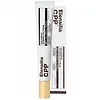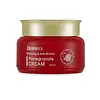What's inside
What's inside
 Key Ingredients
Key Ingredients

 Benefits
Benefits

 Concerns
Concerns

 Ingredients Side-by-side
Ingredients Side-by-side

Collagen Extract
Skin ConditioningGlycerin
HumectantWater
Skin ConditioningNiacinamide
SmoothingDimethicone
EmollientHydrogenated Polydecene
EmollientButylene Glycol
HumectantTriethylhexanoin
MaskingCetearyl Alcohol
EmollientSodium Acrylate/Sodium Acryloyldimethyl Taurate Copolymer
Emulsion StabilisingPolyglyceryl-3 Methylglucose Distearate
EmulsifyingCyclopentasiloxane
EmollientButyrospermum Parkii Butter
Skin ConditioningDimethicone/Vinyl Dimethicone Crosspolymer
Skin ConditioningIsohexadecane
EmollientGlyceryl Caprylate
EmollientSodium Polyacrylate
AbsorbentAmmonium Acryloyldimethyltaurate/Vp Copolymer
Polysorbate 80
EmulsifyingChlorphenesin
AntimicrobialHydrogenated Lecithin
EmulsifyingGlycosaminoglycans
EmollientSteareth-20
CleansingAdenosine
Skin ConditioningSorbitan Oleate
EmulsifyingAllantoin
Skin ConditioningHippophae Rhamnoides Oil
EmollientDisodium EDTA
Theobroma Cacao Extract
Skin ConditioningDextrin
AbsorbentT-Butyl Alcohol
PerfumingN-Hydroxysuccinimide
Skin ConditioningPalmitoyl Tripeptide-5
Skin ConditioningGold
Cosmetic Colorant1,2-Hexanediol
Skin ConditioningGlycine
BufferingChrysin
Skin ConditioningPalmitoyl Tripeptide-1
Skin ConditioningSerine
MaskingGlutamic Acid
HumectantPalmitoyl Tetrapeptide-7
Skin ConditioningBeta-Glucan
Skin ConditioningAspartic Acid
MaskingLeucine
Skin ConditioningAlanine
MaskingLysine
Skin ConditioningArginine
MaskingTyrosine
MaskingPhenylalanine
MaskingThreonine
Proline
Skin ConditioningValine
MaskingIsoleucine
Skin ConditioningHistidine
HumectantMethionine
Skin ConditioningCysteine
AntioxidantCollagen Extract, Glycerin, Water, Niacinamide, Dimethicone, Hydrogenated Polydecene, Butylene Glycol, Triethylhexanoin, Cetearyl Alcohol, Sodium Acrylate/Sodium Acryloyldimethyl Taurate Copolymer, Polyglyceryl-3 Methylglucose Distearate, Cyclopentasiloxane, Butyrospermum Parkii Butter, Dimethicone/Vinyl Dimethicone Crosspolymer, Isohexadecane, Glyceryl Caprylate, Sodium Polyacrylate, Ammonium Acryloyldimethyltaurate/Vp Copolymer, Polysorbate 80, Chlorphenesin, Hydrogenated Lecithin, Glycosaminoglycans, Steareth-20, Adenosine, Sorbitan Oleate, Allantoin, Hippophae Rhamnoides Oil, Disodium EDTA, Theobroma Cacao Extract, Dextrin, T-Butyl Alcohol, N-Hydroxysuccinimide, Palmitoyl Tripeptide-5, Gold, 1,2-Hexanediol, Glycine, Chrysin, Palmitoyl Tripeptide-1, Serine, Glutamic Acid, Palmitoyl Tetrapeptide-7, Beta-Glucan, Aspartic Acid, Leucine, Alanine, Lysine, Arginine, Tyrosine, Phenylalanine, Threonine, Proline, Valine, Isoleucine, Histidine, Methionine, Cysteine
Water
Skin ConditioningParaffinum Liquidum
EmollientGlycerin
HumectantButylene Glycol
HumectantIsopropyl Myristate
EmollientNiacinamide
SmoothingGlyceryl Stearate
EmollientCyclopentasiloxane
EmollientPolysorbate 60
EmulsifyingPetrolatum
EmollientCaprylic/Capric Triglyceride
MaskingStearyl Alcohol
EmollientStearic Acid
CleansingCetyl Alcohol
EmollientBeeswax
Emulsion StabilisingPunica Granatum Fruit Extract
AntioxidantAllantoin
Skin ConditioningPEG-100 Stearate
Cyclohexasiloxane
EmollientSorbitan Stearate
EmulsifyingAdenosine
Skin ConditioningDisodium EDTA
1,2-Hexanediol
Skin ConditioningSodium Hyaluronate
HumectantHydrolyzed Collagen
EmollientDimethicone
EmollientPhenoxyethanol
PreservativeCarbomer
Emulsion StabilisingTriethanolamine
BufferingBenzophenone-9
UV AbsorberPropylparaben
PreservativeMethylparaben
PreservativeParfum
MaskingCI 17200
Cosmetic ColorantWater, Paraffinum Liquidum, Glycerin, Butylene Glycol, Isopropyl Myristate, Niacinamide, Glyceryl Stearate, Cyclopentasiloxane, Polysorbate 60, Petrolatum, Caprylic/Capric Triglyceride, Stearyl Alcohol, Stearic Acid, Cetyl Alcohol, Beeswax, Punica Granatum Fruit Extract, Allantoin, PEG-100 Stearate, Cyclohexasiloxane, Sorbitan Stearate, Adenosine, Disodium EDTA, 1,2-Hexanediol, Sodium Hyaluronate, Hydrolyzed Collagen, Dimethicone, Phenoxyethanol, Carbomer, Triethanolamine, Benzophenone-9, Propylparaben, Methylparaben, Parfum, CI 17200
Ingredients Explained
These ingredients are found in both products.
Ingredients higher up in an ingredient list are typically present in a larger amount.
1,2-Hexanediol is a synthetic liquid and another multi-functional powerhouse.
It is a:
- Humectant, drawing moisture into the skin
- Emollient, helping to soften skin
- Solvent, dispersing and stabilizing formulas
- Preservative booster, enhancing the antimicrobial activity of other preservatives
Adenosine is in every living organism. It is one of four components in nucleic acids that helps store our DNA.
Adenosine has many benefits when used. These benefits include hydrating the skin, smoothing skin, and reducing wrinkles. Once applied, adenosine increases collagen production. It also helps with improving firmness and tissue repair.
Studies have found adenosine may also help with wound healing.
In skincare products, Adenosine is usually derived from yeast.
Learn more about AdenosineAllantoin is a soothing ingredient known for its protective and moisturizingg properties. Because of this, it is often added to products with strong active ingredients.
Studies show higher concentrations of this ingredient can promote wound healing.
Though it can be derived from the comfrey plant, allantoin is produced synthetically for cosmetic products to ensure purity.
Learn more about AllantoinButylene Glycol (or BG) is used within cosmetic products for a few different reasons:
Overall, Butylene Glycol is a safe and well-rounded ingredient that works well with other ingredients.
Though this ingredient works well with most skin types, some people with sensitive skin may experience a reaction such as allergic rashes, closed comedones, or itchiness.
Learn more about Butylene GlycolCyclopentasiloxane, or D5, is a silicone used to improve texture of products and trap moisture.
D5 is considered lightweight and volatile. Volatile means it evaporates quickly after application. Once evaporated, D5 leaves a thin barrier that helps keep skin hydrated.
It is also an emollient. Emollients help soften the skin and prevent water loss. Silicones create a silky texture in products. D5 helps other ingredients become more spreadable.
Studies show D5 is safe to use in skincare products. We recommend speaking with a skincare professional if you have concerns.
Learn more about CyclopentasiloxaneDimethicone is a type of synthetic silicone created from natural materials such as quartz.
What it does:
Dimethicone comes in different viscosities:
Depending on the viscosity, dimethicone has different properties.
Ingredients lists don't always show which type is used, so we recommend reaching out to the brand if you have questions about the viscosity.
This ingredient is unlikely to cause irritation because it does not get absorbed into skin. However, people with silicone allergies should be careful about using this ingredient.
Note: Dimethicone may contribute to pilling. This is because it is not oil or water soluble, so pilling may occur when layered with products. When mixed with heavy oils in a formula, the outcome is also quite greasy.
Learn more about DimethiconeDisodium EDTA plays a role in making products more stable by aiding other preservatives.
It is a chelating agent, meaning it neutralizes metal ions that may be found in a product.
Disodium EDTA is a salt of edetic acid and is found to be safe in cosmetic ingredients.
Learn more about Disodium EDTAGlycerin is already naturally found in your skin. It helps moisturize and protect your skin.
A study from 2016 found glycerin to be more effective as a humectant than AHAs and hyaluronic acid.
As a humectant, it helps the skin stay hydrated by pulling moisture to your skin. The low molecular weight of glycerin allows it to pull moisture into the deeper layers of your skin.
Hydrated skin improves your skin barrier; Your skin barrier helps protect against irritants and bacteria.
Glycerin has also been found to have antimicrobial and antiviral properties. Due to these properties, glycerin is often used in wound and burn treatments.
In cosmetics, glycerin is usually derived from plants such as soybean or palm. However, it can also be sourced from animals, such as tallow or animal fat.
This ingredient is organic, colorless, odorless, and non-toxic.
Glycerin is the name for this ingredient in American English. British English uses Glycerol/Glycerine.
Learn more about GlycerinNiacinamide is a multitasking form of vitamin B3 that strengthens the skin barrier, reduces pores and dark spots, regulates oil, and improves signs of aging.
And the best part? It's gentle and well-tolerated by most skin types, including sensitive and reactive skin.
You might have heard of "niacin flush", or the reddening of skin that causes itchiness. Niacinamide has not been found to cause this.
In very rare cases, some individuals may not be able to tolerate niacinamide at all or experience an allergic reaction to it.
If you are experiencing flaking, irritation, and dryness with this ingredient, be sure to double check all your products as this ingredient can be found in all categories of skincare.
When incorporating niacinamide into your routine, look out for concentration amounts. Typically, 5% niacinamide provides benefits such as fading dark spots. However, if you have sensitive skin, it is better to begin with a smaller concentration.
When you apply niacinamide to your skin, your body converts it into nicotinamide adenine dinucleotide (NAD). NAD is an essential coenzyme that is already found in your cells as "fuel" and powers countless biological processes.
In your skin, NAD helps repair cell damage, produce new healthy cells, support collagen production, strengthen the skin barrier, and fight environmental stressors (like UV and pollution).
Our natural NAD levels start to decline with age, leading to slower skin repair, visible aging, and a weaker skin barrier. By providing your skin niacinamide, you're recharging your skin's NAD levels. This leads to stronger, healthier, and younger looking skin.
Another name for vitamin B3 is nicotinamide. This vitamin is water-soluble and our bodies don't store it. We obtain Vitamin B3 from either food or skincare. Meat, fish, wheat, yeast, and leafy greens contain vitamin B3.
The type of niacinamide used in skincare is synthetically created.
Learn more about NiacinamideWater. It's the most common cosmetic ingredient of all. You'll usually see it at the top of ingredient lists, meaning that it makes up the largest part of the product.
So why is it so popular? Water most often acts as a solvent - this means that it helps dissolve other ingredients into the formulation.
You'll also recognize water as that liquid we all need to stay alive. If you see this, drink a glass of water. Stay hydrated!
Learn more about Water